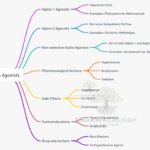Introduction to Beta Receptors:
Beta receptors are adrenergic receptors that respond to the neurotransmitters epinephrine (adrenaline) and norepinephrine (noradrenaline). They are part of the G-protein-coupled receptor family and play a crucial role in the sympathetic nervous system, responsible for the “fight or flight” response. There are three main types of beta receptors: beta-1 (β1), beta-2 (β2), and beta-3 (β3).
Location and Actions of Beta Receptors:
-
Beta-1 Receptors (β1):
- Location:
- Heart: Predominantly found in the sinoatrial node, atria, and ventricles.
- Kidneys: Located in the juxtaglomerular cells.
- Actions:
- Heart: Stimulation of β1 receptors increases the heart rate (positive chronotropic effect) and strengthens the force of the heart’s contraction (positive inotropic effect).
- Kidneys: Activation in the kidneys leads to the release of renin, which plays a role in blood pressure regulation.
- Location:
-
Beta-2 Receptors (β2):
- Location:
- Lungs: Present in the bronchial smooth muscle.
- Blood Vessels: Found in the arterioles of skeletal muscle.
- Uterus: Especially in pregnant women, leading to relaxation of uterine smooth muscle.
- Liver: Involved in glycogenolysis.
- Skeletal Muscle: Play a role in muscle contraction and potassium uptake.
- Actions:
- Lungs: Activation leads to bronchodilation, making it easier to breathe. This is why drugs targeting β2 receptors are used to treat conditions like asthma and COPD.
- Blood Vessels: Lead to vasodilation, especially in the skeletal muscles.
- Liver: Promote the breakdown of glycogen to glucose, increasing blood glucose levels.
- Skeletal Muscle: Involved in potassium uptake, which can lead to decreased blood potassium levels.
- Location:
-
Beta-3 Receptors (β3):
- Location:
- Adipose Tissue: Play a role in lipolysis.
- Urinary Bladder: Found in the detrusor muscle.
- Actions:
- Adipose Tissue: Activation leads to the breakdown of fats, increasing the levels of free fatty acids in the bloodstream.
- Urinary Bladder: Relaxation of the detrusor muscle, which can help in managing overactive bladder symptoms.
- Location:
Signal Transduction of Beta Receptors:
When their ligands (epinephrine or norepinephrine) activate beta receptors, they start a chain of intracellular events through a second messenger system. The primary second messenger involved with beta receptors is cyclic adenosine monophosphate (cAMP).
- Activation of the Receptor: When a ligand binds to the beta receptor, it undergoes a conformational change, allowing it to activate an associated G-protein.
- G-Protein Activation: The G-protein is a trimeric protein with three subunits: α, β, and γ. Upon receptor activation, the α subunit exchanges GDP (guanosine diphosphate) for GTP (guanosine triphosphate) and becomes activated.
- Adenylyl Cyclase Activation: The activated α subunit of the G-protein then interacts with and activates an enzyme called adenylyl cyclase.
- cAMP Production: Adenylyl cyclase catalyzes the conversion of ATP (adenosine triphosphate) to cAMP. The initial signal that the ligand binding to the receptor started amplifies as a result of this rise in cAMP levels inside the cell.
- Protein Kinase A Activation: Elevated cAMP levels activate an enzyme called protein kinase A (PKA). PKA is a serine/threonine kinase that can phosphorylate various target proteins, leading to changes in their activity.
- Final Cellular Response: Depending on the cell type and the specific proteins present, the activation of PKA can lead to various cellular responses. For instance:
- In heart cells, PKA phosphorylates calcium channels and other proteins, leading to increased heart rate and force of contraction.
- In bronchial smooth muscle cells, PKA promotes relaxation, resulting in bronchodilation.
- In liver cells, PKA activates enzymes involved in glycogenolysis, leading to increased blood glucose levels.
The second messenger system, particularly the cAMP pathway, plays a pivotal role in amplifying and transducing the signals initiated by the binding of ligands to beta receptors. This intricate cascade of events allows for precise and coordinated cellular responses to external stimuli, ensuring that the body can adapt and respond appropriately to changing conditions.

Conclusion:
Beta receptors play a pivotal role in various physiological processes, from regulating heart rate and blood pressure to bronchodilation and metabolism. Understanding their location and actions is crucial for therapeutic drug application that targets these receptors and for understanding certain disease processes.
📚 AI Pharma Quiz Generator
🎉 Quiz Results
Medical Disclaimer
The medical information on this post is for general educational purposes only and is provided by Pharmacology Mentor. While we strive to keep content current and accurate, Pharmacology Mentor makes no representations or warranties, express or implied, regarding the completeness, accuracy, reliability, suitability, or availability of the post, the website, or any information, products, services, or related graphics for any purpose. This content is not a substitute for professional medical advice, diagnosis, or treatment; always seek the advice of your physician or other qualified health provider with any questions you may have regarding a medical condition and never disregard or delay seeking professional advice because of something you have read here. Reliance on any information provided is solely at your own risk.









